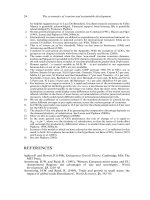THE ECONOMICS OF MONEY,BANKING, AND FINANCIAL MARKETS 380
Bạn đang xem bản rút gọn của tài liệu. Xem và tải ngay bản đầy đủ của tài liệu tại đây (33.34 KB, 1 trang )
348
PA R T I V
The Management of Financial Institutions
in one year s time that it will want to invest in the 6s of 2030 but worries that interest rates on these bonds will decline between now and next year. By using the forward contract, it is able to lock in the 6% interest rate on the Canada bonds (which
will be sold to it by the First Bank).
Pros and Cons
of Forward
Contracts
The advantage of forward contracts is that they can be as flexible as the parties
involved want them to be. This means that an institution like the First Bank may
be able to hedge completely the interest-rate risk for the exact security it is holding in its portfolio, just as it has in our example.
However, forward contracts suffer from two problems that severely limit their
usefulness. The first is that it may be very hard for an institution like the First Bank
to find another party (called a counterparty) to make the contract with. There are
brokers to facilitate the matching up of parties like the First Bank with the Rock
Solid Insurance Company, but there may be few institutions that want to engage
in a forward contract specifically for the 6s of 2030. This means that it may prove
impossible to find a counterparty when a financial institution like the First Bank
wants to make a specific type of forward contract. Furthermore, even if the First
Bank finds a counterparty, it may not get as high a price as it wants because there
may not be anyone else to make the deal with. A serious problem for the market
in interest-rate forward contracts, then, is that it may be difficult to make the financial transaction or that it will have to be made at a disadvantageous price; in the
parlance of the financial world, this market suffers from a lack of liquidity. (Note
that this use of the term liquidity when it is applied to a market is somewhat
broader than its use when it is applied to an asset. For an asset, liquidity refers to
the ease with which the asset can be turned into cash, whereas for a market, liquidity refers to the ease of carrying out financial transactions.)
The second problem with forward contracts is that they are subject to default
risk. Suppose that in one year s time, interest rates rise so that the price of the
6s of 2030 falls. The Rock Solid Insurance Company might then decide that it
would like to default on the forward contract with the First Bank because it can
now buy the bonds at a price lower than the agreed price in the forward contract.
Or perhaps Rock Solid may not have been rock solid and will have gone bust
during the year and so is no longer available to complete the terms of the forward contract. Because there is no outside organization guaranteeing the contract, the only recourse is for the First Bank to go to the courts to sue Rock Solid,
but this process will be costly. Furthermore, if Rock Solid is already bankrupt, the
First Bank will suffer a loss; the bank can no longer sell the 6s of 2030 at the price
it had agreed with Rock Solid but instead will have to sell at a price well below
that because the price of these bonds has fallen.
The presence of default risk in forward contracts means that parties to these
contracts must check each other out to be sure that the counterparty is both financially sound and likely to be honest and live up to its contractual obligations.
Because this is a costly process and because all the adverse selection and moral
hazard problems discussed in earlier chapters apply, default risk is a major barrier
to the use of interest-rate forward contracts. When the default risk problem is
combined with a lack of liquidity, we see that these contracts may be of limited
usefulness to financial institutions. Although there is a market for interest-rate forward contracts, particularly in mortgage-backed and Canada securities, it is not
nearly as large as the financial futures market, to which we turn next.









